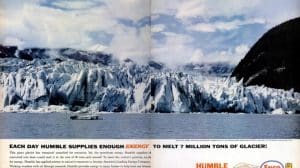 We are excited to introduce our Terminal Article Series — a weekly publication designed to share perspectives, expertise, and developments shaping terminal operations. Beginning today, and continuing on Thursdays, we will publish a new installment offering insights drawn from our experience, partnerships, and ongoing work within the terminal sector.
We are excited to introduce our Terminal Article Series — a weekly publication designed to share perspectives, expertise, and developments shaping terminal operations. Beginning today, and continuing on Thursdays, we will publish a new installment offering insights drawn from our experience, partnerships, and ongoing work within the terminal sector.
Contributed by Todd Perry, CEO, PPM Consultants
Every now and then, an artifact from the past shows us just how much the conversation about energy has changed. I recently came across a 1962 advertisement from Humble Oil & Refining Company—what we know today as Exxon. It featured a massive glacier and proudly declared: “Each day Humble supplies enough energy to melt 7 million tons of glacier!” At the time, this was a message of strength. It was meant to highlight the sheer scale of America’s energy capacity—the ability to deliver oil and gasoline across a growing nation. Today, of course, we look at it with different eyes. What was once framed as a boast now reads more like an unintended warning. Yet underneath the irony, that ad captured something enduring: energy is the engine of American prosperity. Without it, the country doesn’t move. And while the conversation has shifted over the decades—from abundance to efficiency, from power to stewardship—the backbone of our energy system remains largely the same. It’s not only the fuel pump where we see the product that matters most, but the network behind the scenes—the pipelines and terminals—that truly make the system work.
 The story of America’s pipelines begins in the late 1800s, when crude oil from Pennsylvania fields was hauled in horse-drawn wagons and loaded into barrels on railcars. It was slow, costly, and dangerous. In 1865, a two-inch iron pipe laid across five miles of rugged terrain proved that oil could move by pipeline faster, cheaper, and safer than by rail. That experiment launched a new era. Still, the system grew unevenly at first. Railroads fought pipelines bitterly, fearing the loss of their lucrative oil freight business. Only in the early 20th century, as cars rolled off Henry Ford’s assembly lines, did the logic become undeniable: America’s future required a new kind of energy infrastructure.
The story of America’s pipelines begins in the late 1800s, when crude oil from Pennsylvania fields was hauled in horse-drawn wagons and loaded into barrels on railcars. It was slow, costly, and dangerous. In 1865, a two-inch iron pipe laid across five miles of rugged terrain proved that oil could move by pipeline faster, cheaper, and safer than by rail. That experiment launched a new era. Still, the system grew unevenly at first. Railroads fought pipelines bitterly, fearing the loss of their lucrative oil freight business. Only in the early 20th century, as cars rolled off Henry Ford’s assembly lines, did the logic become undeniable: America’s future required a new kind of energy infrastructure.
The turning point came during World War II. German U-boats prowled the Atlantic, sinking American tankers carrying oil from the Gulf Coast to the East Coast. Energy security became a matter of national survival. Washington responded by building two extraordinary pipelines: the 24-inch “Big Inch” and the 20-inch “Little Big Inch,” stretching nearly 1,500 miles from Texas to Pennsylvania. Completed in less than two years, these pipelines carried millions of barrels of crude and refined fuel safely to the Northeast, beyond the reach of submarines. They were feats of engineering and urgency, a reminder that America’s ability to fight and win depended on the invisible arteries of energy flowing beneath its soil.
When the war ended, demand for oil products only grew. Returning soldiers bought homes, highways expanded, airlines boomed, and the suburbs filled with cars. Pipelines and terminals multiplied to meet this growth. Perhaps the most significant development came in 1963 with the creation of the Colonial Pipeline Company. Built to connect the refining hubs of the Gulf Coast with the population centers of the East Coast, Colonial’s 5,500-mile system became the largest refined product pipeline in the United States. At full capacity, it moves about 100 million gallons of gasoline, diesel, and jet fuel every day—roughly 45 percent of the East Coast’s total supply. For six decades, it has quietly done its job, so reliably that most people never thought twice about it—until a cyberattack in 2021 temporarily shut it down, reminding us just how dependent the nation is on this unseen backbone.
Other systems grew alongside Colonial. The Magellan Midstream network, today spanning over 9,000 miles, emerged to serve the Midwest and Gulf Coast. The Buckeye system carried fuel through the Northeast, while the Plantation Pipeline became a key supply line for the Southeast. Terminals sprang up in every major metro area, storing hundreds of thousands of barrels of fuel and serving as the loading points where tanker trucks took over the final leg of the journey. By the 1960s—the same era when Humble Oil was boasting about melting glaciers—the United States already had tens of thousands of miles of pipelines quietly fueling its prosperity.
Fast forward to today, and the numbers are staggering. The U.S. now has roughly 190,000 miles of liquid petroleum pipelines and more than 1,400 product terminals. Together, they form one of the most advanced and efficient energy networks in the world. A single large pipeline can move more product in a day than thousands of tanker trucks. Colonial’s daily throughput, for instance, is the equivalent of filling more than five million passenger cars. Terminals, with their sprawling tanks and sophisticated blending equipment, act as buffers to ensure that supply disruptions don’t immediately hit consumers. They balance surpluses and shortages, absorb shocks, and keep the system humming. For most Americans, the only visible part of this system is the local station where they fill up. But the certainty of supply—the confidence that fuel will be available when it’s needed—begins long before the pump. It comes from the network we don’t see, the backbone of pipelines and terminals working quietly behind the scenes.
This hidden network is vital not only for convenience but also for security. The Colonial Pipeline cyberattack showed how quickly supply interruptions can ripple through communities. Gas stations along the East Coast ran dry within days. Lines stretched around the block. What had been invisible suddenly became front-page news. Energy security isn’t an abstract concept—it’s a lived reality when supply chains are disrupted. Fuel is the circulatory system of the economy. Farmers don’t plant or harvest without diesel. Airlines don’t fly without jet fuel. Trucking fleets don’t deliver food, medicine, or goods without gasoline and diesel. Manufacturing plants can’t run without steady energy deliveries. Every piece of the modern economy depends on the reliable flow of fuel, and that flow depends on pipelines and terminals.
Contrary to some perceptions, pipelines are also the most efficient and environmentally responsible way to move petroleum products. By operating underground, they reduce surface congestion, emissions, and traffic accidents. With modern monitoring, smart sensors, and advanced leak detection, the system continues to become safer and more reliable each year. It would be easy to look back at that 1962 Humble Oil ad and scoff at its hubris. But I see it differently. It was a reflection of its time, an era when energy abundance was the great American promise. That promise built highways, fueled the aerospace industry, and drove economic growth for generations. The men who wrote that ad weren’t trying to melt glaciers—they were trying to assure Americans that the fuel would be there when they needed it. That promise is still worth honoring.
Today, we’re in a new chapter. We still need the backbone of pipelines and terminals, but we also need innovation layered on top of it. Cleaner fuels, smarter logistics, and technology-driven efficiency aren’t replacements for infrastructure—they are enhancements. A conservative perspective recognizes that energy is not an enemy but a necessity, and that while stewardship matters, so too does strength. Pipelines and terminals are not relics; they remain the foundation of the system that powers America’s prosperity.
The conversation about energy will continue to evolve, just as it has since the glacier ad ran in 1962. But no matter how we talk about it, the fundamentals remain. Americans need to know that when they turn the key in the ignition, board a plane, or harvest a field, the fuel will be there. That confidence begins well before the pump, in the unseen network that moves billions of gallons of energy quietly and efficiently across the nation. So, the next time you see a tanker truck pulling away from a terminal or drive past a fenced-off pipeline station, remember that you’re not just looking at steel or concrete. You’re looking at America’s energy backbone at work. And while the messages may change—from boasting about melting glaciers to emphasizing efficiency and stewardship—the truth is the same today as it was in 1962. Energy makes America move. Our job is to make sure the backbone stays strong.


